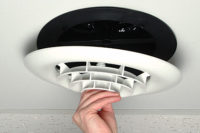The stack effect and wind are natural forces that provide the air pressure to force out stale air, which in turn sucks in fresh air. Clothes driers, bath fans, and kitchen exhaust hoods also force fresh air into our homes.
As seasonal temperatures moderate, air change rates decline. The wind comes and goes. As a result, homes have a variable fresh air change rate from these variable natural forces.
In tighter homes, the days of inadequate fresh air ventilation increase to the point where indoor air pollutants in most homes become elevated, and may endanger the health of the occupants. Also, homes with high occupancy have less-than-ideal oxygen levels.
Below, I have provided some basic guidelines for helping customers achieve the kind of IAQ they want, in a controlled way.
IAQ BASICS
Fresh air change rate - dilution:Purging indoor pollutants and optimizing oxygen levels in the home are the goals of most ventilations standards. Most standards suggest a mechanical fresh air change every 4-6 hours, at a minimum, when the home is occupied.For example, 2,000 square feet x 9-foot ceiling/5 hours = 75 cfm of fresh air needed during occupied periods. This is the amount of air required to purge indoor pollutants; 75 cfm of fresh air supports up to six occupants with adequate oxygen levels.
Ventilating with more fresh air for additional dilution of specific pollutants may be required. Most new standards require mechanical ventilation rates when the space is occupied.
Source control:Indoor pollutants may include interior smoke, cooking gases, hobby/cleaning materials, dormant mold, and residual dust mite allergens inside the home.
Volatile organic compounds (VOCs) like formaldehyde should be minimized as much as possible. If a customer is sensitive to exterior or interior pollutants, special filtering/treatment may be needed for the entering fresh and interior air in the home.
Maintain less than 55 percent rh:Maintaining less than 55 percent rh in the interior space and on cold surfaces can help prevent biological growth and optimize interior space comfort. Most homes are 68°-78°F when occupied. Occupants add 0.5 pounds of moisture per hour.
Typically, the 75 cfm of fresh air with less than 50° dew point keeps the home at less than 55 percent rh.
High humidity is acceptable for less than 24 hours. High humidity for more than 24 hours reactivates mold growth and other biologicals. In “green grass” climates, the outdoor dew point can be higher than 60°. With greater than 60° outdoor dew points, dehumidification is required during low/no cooling loads to maintain less than 50 percent rh. This is important for both health and comfort.
Filter fresh/interior air:Filter fine particulate and hazardous gaseous material from fresh/interior air, using a filter with greater than the MERV 11 minimum. Other filter media, like activated charcoal/potassium permanganate, may be required for special cases.
CHOOSING EQUIPMENT
For arid climates:In the arid parts of the world, a simple fan with a MERV 11-plus air filter, blending the desired amount of fresh air with the air in the home, may be adequate. If the outside/inside difference is minor, no treatment of the fresh air is required. Many arid climates have a rainy time of the year that may last a couple of weeks.Days of greater than 70 percent-rh indoor humidity carry a risk of growing mold on the cool surfaces of the structure. If occupants are sensitive to mold, dehumidification is needed during periods of high outdoor dew points. Dehumidify to less than 50 percent rh to avoid elevated indoor humidity.
For moderate, green grass climates:These climates have weeks of high outdoor dew points with low or no cooling loads. Providing fresh air ventilation during high outdoor dew points, while maintaining less than 50 percent rh, is challenging.
Fan-powered, filtered fresh air, blended and circulated throughout the home, is the primary need, with enough dehumidification to remove 1-4 pounds of moisture.
During peak cooling loads, with controlled fresh air the a/c can maintain less than 50 percent rh. During evenings, on rainy days, and with moderate outdoor temperatures, the a/c will not maintain less than 50 percent rh, so supplemental dehumidification is required.
(A relatively new concept is to provide fresh air ventilation and whole-house dehumidification with a whole-house ventilating dehumidifier. These units are connected to the a/c, blending the filtered fresh air with the house air and circulating the blend throughout the home.)
During periods of extreme cold, for very air-tight homes in green grass climates, contractors may apply an air-to-air heat exchanger that may also be included with a whole-house dehumidifier.
Publication date: 04/18/2011









